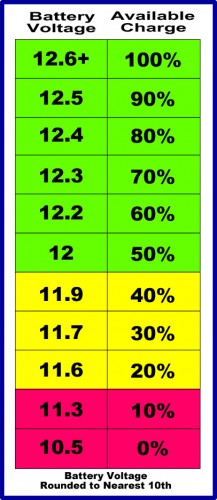

When it’s really hot outside, keep batteries in the fridge. After each use, remove the batteries from the devices.
#D BATTERY VOLTAGE CHART HOW TO#
How to Extend the Life of Disposable Batteries When you’re not using anything, turn it off. These alkaline batteries may be stored for up to ten years and are particularly good at powering low-to-medium-drain gadgets.Īlso, it is asked, How can I make my D batteries last longer? Similarly, What D cell batteries last the longest?Įnergizer Max D Batteries are the best overall.

The rechargeable variety, on the other hand, lasts for roughly 2-3 years before needing to be recharged. In such cases, the specific gravity and the voltages may vary from what we show.In continual usage, main D batteries last around 36 hours and 3 minutes on average. The electrolyte may be stronger (for cold) or weaker (for very hot) climates. One last note on temperatures – in some places that have extremely cold or hot conditions, batteries may be sold locally that are NOT standard electrolyte (acid) strengths. This is actually not as bad as it seems, as the battery will tend to average out the good and bad times. This holds true for ANY type of lead-acid battery, whether sealed, Gel, AGM, industrial or whatever. Battery life is reduced at higher temperatures – for every 15 degrees F over 77, battery life is cut in half. Battery capacity is reduced by 50% at -22 degrees F – but battery LIFE increases by about 60%. Battery life reduces at higher temperaturesĮven though battery capacity at high temperatures is higher, battery life is shortened. The sensor will then read very close to the actual internal battery temperature. For this reason, external (add-on) temperature sensors should be attached to one of the POSITIVE plate terminals, and bundled up a little with some type of insulation on the terminal. A large insulated battery bank may vary as little as 10 degrees over 24 hours internally, even though the air temperature varies from 20 to 70 degrees. Thermal mass means that because they have so much mass, they will change internal temperature much slower than the surrounding air temperature. This is why you should have temperature compensation on your lead-acid battery charger or charge control if your batteries are outside and/or subject to wide temperature variations. It will vary from about 2.74 volts per cell (16.4 volts) at -40 C to 2.3 volts per cell (13.8 volts) at 50 C. Wide temperature variationsīattery charging voltage also changes with temperature. Capacity is increased at higher temperatures – at 122 degrees F, battery capacity would be about 12% higher.

At approximately -22 degrees F (-30 C), battery Ah capacity drops to 50%. The standard rating for batteries is at room temperature 25 degrees C (about 77 F).

If your batteries spend part of the year shivering in the cold, the reduced capacity has to be taken into account when sizing the system batteries. This is why your car battery dies on a cold winter morning, even though it worked fine the previous afternoon. Battery capacity (how many amp-hours it can hold) is reduced as temperature goes down, and increased as temperature goes up.


 0 kommentar(er)
0 kommentar(er)
